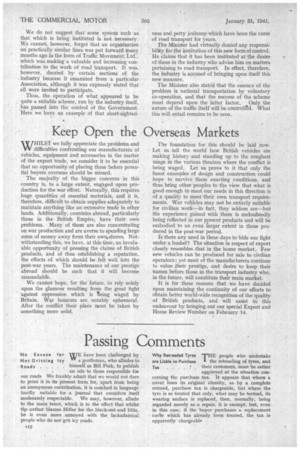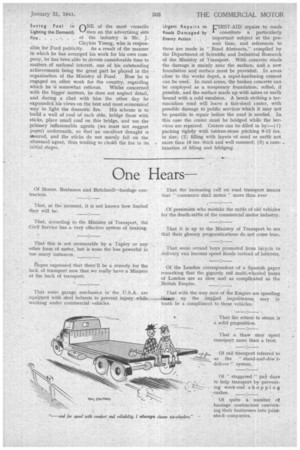Passing Comments
Page 14

Page 15

If you've noticed an error in this article please click here to report it so we can fix it.
No Excuse for yJE liave been challenged by Not Gritting Icy TY a gentleman, who alludes to Roads himself as Bill Pink, to publish an ode to those responsible for our roads We frankly admit that we would not dare to print it in its present form for, apart from being an anonymous contribution, it is couched in language hardly suitable for a journal that considers itself moderately respectable. We may, however, allude to the main tenor, which is to the effect that whilst the author blames Hitler for the black-out and blitz, he is even more annoyed with the lackadaisical people who do not grit icy roads. Why Retreaded Tyres THE people who undertake are Liable to Purchase I the retreading of tyres, and
Tax their customers, must be rather
aggrieved at the situation concerning the purchase tax. It appears that where a cover loses its original identity, as by a complete retread, purchase tax is chargeable, but where the tyre is so treated that only, what may be termed, its wearing surface is replaced, then, normally, being regarded merely as a repair, it is exempt, but, even in this case; if the buyer purchases a replacement covr which has already been treated, the tax is apparently chargeable Saving Fuel in rINE of the most versatile Lighting the.Dornestit 1.--Imen on the advertising side
Fire of the industry is Mr. J.
Clayton Young, who is responsible for Ford publicity. As a result of the manner in which he has arranged his work for his own company, he has been able to devote considerable time to matters of national interest, one of his outstanding achievements being the great part he played in the organization of the Ministry of Food. Now he is engaged on other work for the country, regarding which he is somewhat reticent. Whilst concerned with the bigger matters, he does not neglect detail, and during a chat with him the other day he expounded his views on the best and most economical way to light the domestic fire. His scheme is to build a wall of coal at each side, bridge these with sticks, place small coal on this bridge, and use the primary inflammable agents (we must not suggest paper) underneath, so that an excellent draught is assured, and the slicks do not merely fall on the aforesaid agent, thus tending to choke the fire in its initial stages.
Urgent Repairs to MRST-AID repairs to roads Roads Damaged by I constitute a particularly Enemy Action . . important subject at the pre sent time, and references to these are made in' Road Abstracts," compiled by the Department of Scientific and Industrial Research of the Ministry of Transport. With concrete roads the damage is mainly near the surface, and a new foundation and surface must be provided. In areas close to the works depot, a rapid-hardening cement can be used. In rural areas, the broken concrete can be employed as a temporary foundation, rolled; if possible, and the surface made up with ashes or earth bound with a cold emulsion. A bomb striking a tarmacadam road will leave a fair-sized crater, with possible damage to public services which it may riot be possible to repair before the road is needed. Inthis case the crater must be bridged while the services are repaired. Craters can be filled in by:—(1) packing tightly with broken-stone pitching 9-12 ins. in size; (2) filling with layers of sand or earth not more than 18 ins.-thick and well rammed; (3) a coin, bination of filling and bridging.




















































